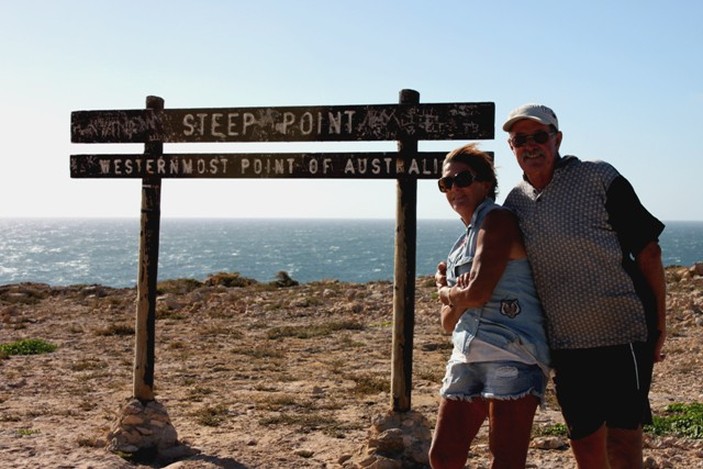
Despite dire predictions about bad roads and rogue waves, despite being sandblasted by Indian Ocean breezes and despite the frustrating buffalo fish, Australia’s most western point on the mainland was a treasure.
It was also an adventure that again proved the worth of our Global Warrior Isabel.
We want to go back to Steep Point sometime but the best months are taken 10 months and two days ahead. That’s the limit for forward bookings at the national park on the headland poking into the ocean on south side of Shark Bay.
“All the sites on top are booked out,” Ranger John said in a Pommie accent when we phoned. “I won’t be there until late but I will put your campsite up on the board.” We had no idea what that meant.
Before negotiating the 100km of sandy road and 40km of loose sand dunes we had to pass the turnoff to Useless Loop, a closed town where evaporation fields create the finest salt in the world. Its intriguing name comes from French explorer Henri-Louis de Saulces de Freycinet, who dubbed the area "Havre Inutile" ("Useless Harbour"), because he believed the inviting harbour to be entirely blocked by a sandbar.
Now the mining company at Useless Loop wins awards for helping save endangered animals especially the burrowing bettong.
Isabel sailed over the corrugations people had warned about and easily climbed over the sand dunes that have a reputation for sucking in 4WDs of all descriptions. She never missed a beat.
We found the ranger camp and peered at the blackboard. It said Ranger John had gone to Useless Loop. We figured we were the Batts at Scavengers. We wondered at the significance of the camp name but it turned out to be a super site inside the Bay with fine sand and cornflower water.
We had intended staying only one night so we could go to the sign and take the picture to prove we had been at the extremity but we ended up staying three. We left with some notable sized whiting in the freezer and a notable catch of fine sand blown into all of Isabel’s crevices. And ours.
Steep Point, further on than Scavengers, itself is a barren piece of rock with some of the best shore fishing in Australia, if you don’t get swept into the sea by a king wave. Gusting winds and sneaky swells are part of the deal. Spray-laden swirls can sweep around crevices and dash you into the ground or hurl you into the ocean, even if you are a fair way back apparently.
A little disappointingly, the ocean was quite well behaved when we arrived, despite the stiff wind. We did the photo thing, had a celebratory beer and retreated a few ks to our sheltered little campsite in the bay. A few of the boys at the “sites on top” turned up there too after giving up for the day.
We threw out lines in and watched in astonishment as a school of sizeable fish, easily visible in the clear water, swam past. Then another one. Then a school came back but catch one of those fish we could not. Tony tempted them all ways he could think of but they were not interested. Fortunately the whiting were and we pulled in some of the best specimens we have ever landed.
We ploughed back over a couple of sand dunes to tell John we wanted to stay another two nights, despite the rising wind. We asked him about the schools of fish. “They’ll be boofooloo bream,” he advised. “You can’t catch them because they eat weed and if you do get one you can’t eat it. They taste terrible.”
We happily caught whiting, watched the buffalo bream (which probably gave Scavengers its name) saunter past and less happily battled the breezes that blew above 60 knots. We gave thanks that we were in Isabel and could retreat in comfort from the sandblasting, unlike the bunch of young Kiwi people two sites away. They were chilling out in little tents, sleeping bags and the backs of utes with a Yamaha pergola that periodically disappeared.
The kite-surfing Aussie among them was unable to get his rig up, which was a good thing as we were quite sure he would disappear towards Hartog Island and maybe further afield. Like Madagascar.
A 4WD with a camper topper appeared beside us on the second night. The topper was gone the next morning.
Apparently the winds abate in glorious weather between Christmas and April but Steep Point camp sites then are booked out 10 months and two days in advance. Who the hell knows where they will be then?
It was also an adventure that again proved the worth of our Global Warrior Isabel.
We want to go back to Steep Point sometime but the best months are taken 10 months and two days ahead. That’s the limit for forward bookings at the national park on the headland poking into the ocean on south side of Shark Bay.
“All the sites on top are booked out,” Ranger John said in a Pommie accent when we phoned. “I won’t be there until late but I will put your campsite up on the board.” We had no idea what that meant.
Before negotiating the 100km of sandy road and 40km of loose sand dunes we had to pass the turnoff to Useless Loop, a closed town where evaporation fields create the finest salt in the world. Its intriguing name comes from French explorer Henri-Louis de Saulces de Freycinet, who dubbed the area "Havre Inutile" ("Useless Harbour"), because he believed the inviting harbour to be entirely blocked by a sandbar.
Now the mining company at Useless Loop wins awards for helping save endangered animals especially the burrowing bettong.
Isabel sailed over the corrugations people had warned about and easily climbed over the sand dunes that have a reputation for sucking in 4WDs of all descriptions. She never missed a beat.
We found the ranger camp and peered at the blackboard. It said Ranger John had gone to Useless Loop. We figured we were the Batts at Scavengers. We wondered at the significance of the camp name but it turned out to be a super site inside the Bay with fine sand and cornflower water.
We had intended staying only one night so we could go to the sign and take the picture to prove we had been at the extremity but we ended up staying three. We left with some notable sized whiting in the freezer and a notable catch of fine sand blown into all of Isabel’s crevices. And ours.
Steep Point, further on than Scavengers, itself is a barren piece of rock with some of the best shore fishing in Australia, if you don’t get swept into the sea by a king wave. Gusting winds and sneaky swells are part of the deal. Spray-laden swirls can sweep around crevices and dash you into the ground or hurl you into the ocean, even if you are a fair way back apparently.
A little disappointingly, the ocean was quite well behaved when we arrived, despite the stiff wind. We did the photo thing, had a celebratory beer and retreated a few ks to our sheltered little campsite in the bay. A few of the boys at the “sites on top” turned up there too after giving up for the day.
We threw out lines in and watched in astonishment as a school of sizeable fish, easily visible in the clear water, swam past. Then another one. Then a school came back but catch one of those fish we could not. Tony tempted them all ways he could think of but they were not interested. Fortunately the whiting were and we pulled in some of the best specimens we have ever landed.
We ploughed back over a couple of sand dunes to tell John we wanted to stay another two nights, despite the rising wind. We asked him about the schools of fish. “They’ll be boofooloo bream,” he advised. “You can’t catch them because they eat weed and if you do get one you can’t eat it. They taste terrible.”
We happily caught whiting, watched the buffalo bream (which probably gave Scavengers its name) saunter past and less happily battled the breezes that blew above 60 knots. We gave thanks that we were in Isabel and could retreat in comfort from the sandblasting, unlike the bunch of young Kiwi people two sites away. They were chilling out in little tents, sleeping bags and the backs of utes with a Yamaha pergola that periodically disappeared.
The kite-surfing Aussie among them was unable to get his rig up, which was a good thing as we were quite sure he would disappear towards Hartog Island and maybe further afield. Like Madagascar.
A 4WD with a camper topper appeared beside us on the second night. The topper was gone the next morning.
Apparently the winds abate in glorious weather between Christmas and April but Steep Point camp sites then are booked out 10 months and two days in advance. Who the hell knows where they will be then?
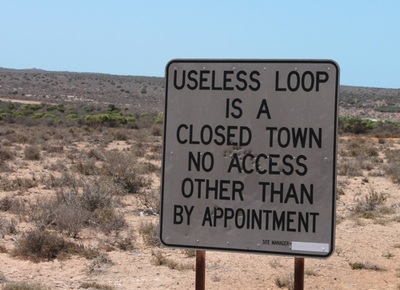
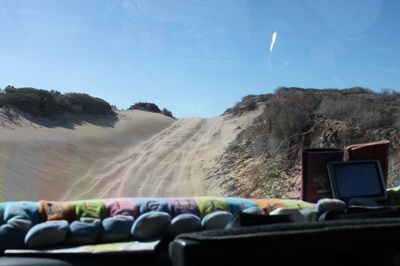
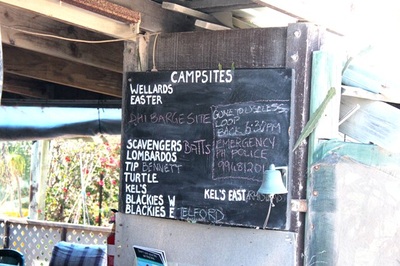
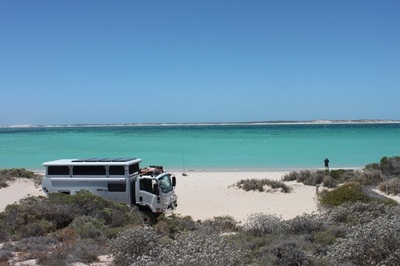
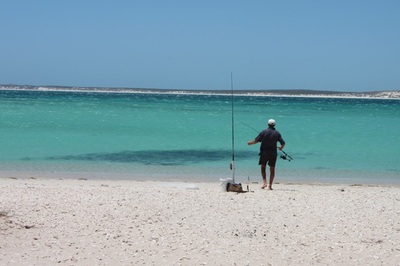
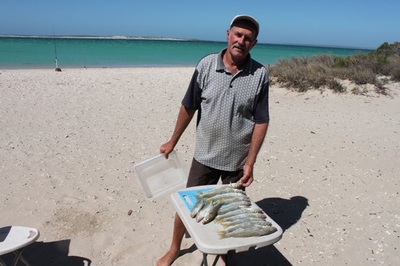
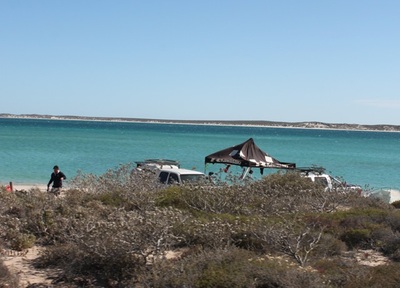
 RSS Feed
RSS Feed
